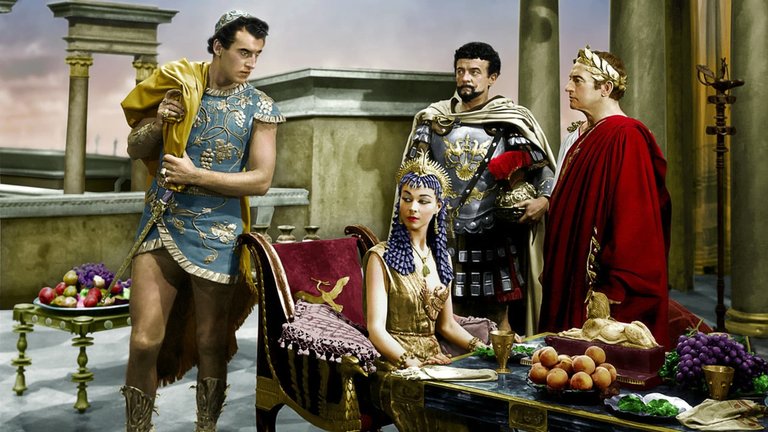
The British film industry, for nearly the entirety of the 20th century, found itself operating under the imposing shadow cast by its Hollywood. However, on certain occasions, British filmmakers were able to rise above this and, in terms of ambition and spectacle, give their American counterparts a run for their money. One such instance occurred in 1945 when Gabriel Pascal's historical epic, Caesar and Cleopatra, broke and briefly held the record as the world's most expensive film made by that point.
Based on the eponymous 1901 stage play by Irish playwright George Bernard Shaw, who also penned the script, the film takes a somewhat loose approach to the historical events that transpired in early 40s BC Egypt. The story centres around Gaius Julius Caesar (played by Claude Rains), a Roman general and statesman who, after defeating the army of his main rival Pompey in civil war, pursues him into Egypt. Pompey, seeking shelter, instead meets a grisly end at the hands of Lucius Septimius (played by Raymond Lovell), a Roman mercenary working for the court advisors of the child king Ptolemy (played by Anthony Harvey).
As Caesar remains in Alexandria under the guise of mediating in the power struggle between Ptolemy and his teenage sister Cleopatra (played by Vivien Leigh), he also seeks to secure vital grain shipments to Rome. Initially scared by the Romans, Cleopatra is gradually drawn to the charismatic Caesar, who takes her under his wing. As Cleopatra transforms from a capricious teenager into a ruthless ruler, the political crisis erupts into violence, with Caesar and his army now facing an Egyptian uprising against Roman rule.
Gabriel Pascal's biggest achievement in Caesar and Cleopatra was that he managed to finish the film, which, considering the circumstances, wasn't that easy. Production coincided with the Second World War, and shooting of certain scenes was affected by German bombing. Pascal's megalomania didn't help matters, as he imported large amounts of sand from Egypt to get the right colour for certain outdoor scenes, and even travelled to Egypt to shoot some of the material. Pascal also didn't spare effort and money when it came to gathering top talent, and with roughly $1 million paid to Claude Rains for playing a title role, the film broke another record.
All this ambition and production woes were, in many ways, similar to Cleopatra, another record-budgeted film epic that would cover the same theme eighteen years later. The results were roughly the same, with Caesar and Cleopatra turning into a massive flop and forcing Pascal to wait for many years before getting another opportunity to make a film.
At first glance, Caesar and Cleopatra looks like the "proper" historic epic, mostly thanks to the use of Technicolor, elaborate sets, exotic costumes, and large numbers of extras. However, whenever the focus of the film turns to characters, it becomes apparent that the film was based on a stage play rather than an original script. There is relatively little action, and most of the plot is presented through descriptive dialogue. The result is a complicated and convoluted plot that, to make things even worse, depends on the audience enjoying the benefits of classical education and being familiar with the historical era and its iconic characters.
Caesar and Cleopatra has an impressive cast, but not all of its members are good, nor could they transcend the limits of the lacklustre script. Claude Rains is the best as the wise and enlightened Roman statesman who also bravely handles the issue of being middle-aged. Vivien Leigh, who was in her thirties during production, isn't that convincing as the silly teenager Cleopatra. Stewart Granger is impressive as the athletic and physically imposing Apollodorus the Sicillian, although his character seems to have arrived from another film by mistake. Flora Robson, while decent as Cleopatra's chief nurse Ftatateeta, might not sit well with some of today's audiences because of the makeup that looks a little bit like blackface.
Inevitably, one must compare this film with the 1963 Cleopatra, which has the advantage of better production values and covering more historical ground. While Caesar and Cleopatra can be considered a watchable film, it is primarily of interest to cinephiles interested in film history and its curiosities.
RATING: 4/10 (+)
Blog in Croatian https://draxblog.com
Blog in English https://draxreview.wordpress.com/
InLeo blog https://inleo.io/@drax.leo
Hiveonboard: https://hiveonboard.com?ref=drax
Rising Star game: https://www.risingstargame.com?referrer=drax
1Inch: https://1inch.exchange/#/r/0x83823d8CCB74F828148258BB4457642124b1328e
BTC donations: 1EWxiMiP6iiG9rger3NuUSd6HByaxQWafG
ETH donations: 0xB305F144323b99e6f8b1d66f5D7DE78B498C32A7
BCH donations: qpvxw0jax79lhmvlgcldkzpqanf03r9cjv8y6gtmk9
Posted Using InLeo Alpha